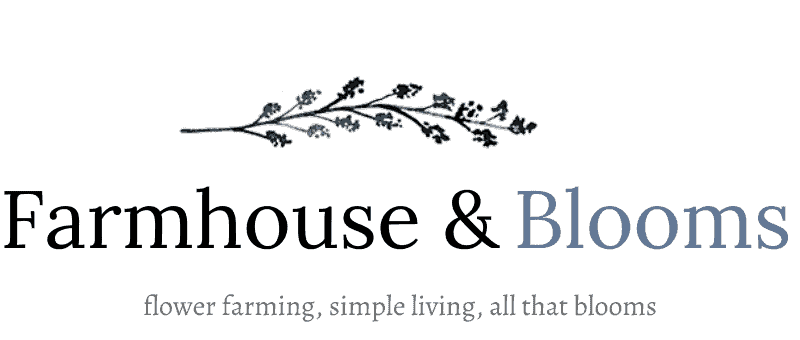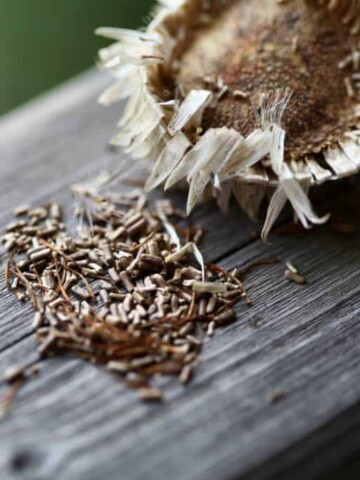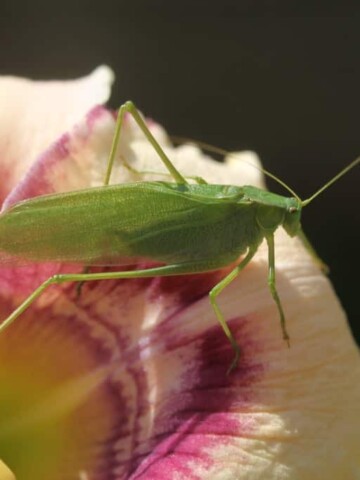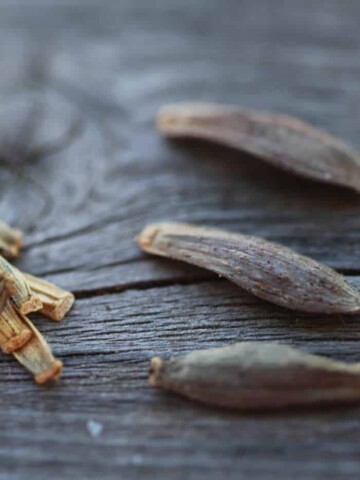Did you know that pinching plants is actually an important gardening technique that can help your plants to grow bushier, and produce more flowers? In fact, it's a technique that many flower farmers use to produce loads of flowers all summer long, from summer until fall. Learn all about the art of pinching plants for growth, and experience a bountiful garden full of blooms this summer.

As an avid gardener and flower farmer, I've always been fascinated by the simple techniques that can make a big difference in the health and flower production of the garden. One such method, which I've come to rely on over the years, at the flower farm especially, is the practice of pinching plants.
Pinching at it's core is a gentle art, where we as gardeners can play a direct role in shaping the growth and the flourishing nature of our plants.
The concept of pinching might sound a bit harsh at first, and it's definitely counterintuitive, because who really wants to cut back a nicely growing seeding? But in practice, it's actually a nurturing gesture, and will help the plant to grow larger and stronger in the long run.

What Is Pinching?
So what exactly is pinching?
Pinching is the act of carefully removing the tip of a plant stem, by "pinching" it or cutting it, from the rest of the stem. The pinching process causes more stems to form from the growth nodes, just below the area of pinching. It can also stimulate the plant to produces more stems from the base of the plant, resulting in more flowers.
This seemingly small action has profound effects. It encourages the plant to branch out, leading to fuller, bushier growth, and in many cases, it prompts a bounty of blooms in a plant that might otherwise not have been so prolific.
Pinching is a practice that requires patience, a soft touch, and a bit of intuition—knowing when and where to pinch can make all the difference.
Most importantly, you should also be aware that not all plants should be pinched, and it can cause more harm than good for some types of plants, so know your plants before you pinch.
For many plants however, the pinching method is a fabulous technique to give your flowering plants a great start to a productive season. It may set you back slightly, as the first flowering bud is pinched off, but the gains outweigh the setback in the long run, as you experience many more flowering stems as a result.
As we dive deeper into the nuances of this technique, I hope to share the joy and rewards that come from this simple act of gardening care.

Plants You Can Pinch
Plants and flowers that benefit from pinching are those that are branching, with multiple stems. These plants have growth nodes along their stems, and the pinching process will stimulate growth from the nodes that are located below the area of the pinched stem.
Pinching encourages these plants to develop more side branches, leading to a fuller plant with more flowers. More stems can also grow up from the base of the plant, for an overall bushier appearance.
The "cut and come again" group of flowers are ideal for pinching. The more they are cut from the more new branches they produce, and this is exactly why. After the initial pinching, these plants continue to be pinched (in a sense) throughout the growing season as stems are cut, stimulating more growth.
These plants often produce longer stems as well, making them great for use as cut flowers.

Some examples of plants and flowers you can pinch include those with branching and multiple stems:
- Amaranth
- Branching sunflowers
- Calendula
- Celosia (branching types)
- Chinese forget me nots
- Cosmos
- Dahlias
- Globe Amaranth
- Marigolds
- Snapdragons
- Sweet peas
- Zinnias

Plants You Shouldn't Pinch
While pinching is beneficial for many plants, there are certain types of flowers and plants that should definitely not be pinched. Therefore, it's important to know your plants, and whether or not they would benefit from pinching.
Pinching some types of plants can either harm their growth pattern, reduce flowering, or negatively affect their overall health.
Plants that should not be pinched include single-stem flowers, plants with a terminal flower bulb, bulb flowers, most succulents and cacti, and perennials with a rosette pattern.
For example, flowers which grow from a single stem, such as sunflowers, can be damaged beyond repair by pinching. I have seen single-stemed sunflowers sometimes produce side shoots after the main flower has been damaged, however these side flowers were not useable.

Some examples of plants and flowers you should not pinch include those with single stems, or those that produce just one flower per plant:
- Bupleurum
- Daffodils
- Daylilies
- Foxgloves
- Lupines
- Poppies
- Russian Sage
- Single-stemmed sunflowers
- Stock
- Statice
- Tulips

The Benefits Of Pinching Plants
Pinching plants is a straightforward yet effective gardening technique. This technique offers numerous benefits for both the plants, and the garden as a whole. Here are some of the key advantages of adding the pinching technique into your gardening routine:
1. Promotes Fuller Growth
By removing the tip of a plant stem, including the terminal bud, pinching encourages the plant to produce new stems from the leaf nodes below the pinched area. This results in bushier plants, rather than leggy ones. The technique can be particularly beneficial for young plants, helping them develop a fuller shape.
2. Increases Flowering
For flowering plants, pinching can stimulate the plant to produce more stems, and therefore more flowers. Removing the growing tips redirects the plant's energy towards the development of lateral branches. This means more beautiful blooms over the season, enhancing the aesthetic appeal of your garden, and giving you a lot more stems for cutting.
3. Makes Plants More Resilient
A bushier plant is often more capable of withstanding adverse conditions, such as drought or high winds. The increased foliage can also help to shade the soil, reducing moisture loss, and a sturdier structure means the plant is less likely to be damaged by wind.
4. Allows For Shaping And Training
Pinching is also a technique for gardeners who wish to shape their plants, or train them to grow in a particular direction. This can be especially useful for creating visually striking garden designs, or for guiding climbers and trailers to cover specific areas.
5. Encourages Dense Foliage
In addition to promoting bushier growth, pinching can also encourage the production of new leaves and denser foliage. This is particularly desirable in ornamental plants where lush, vibrant leaves are valued for their visual impact. Dense foliage can also help reduce weed growth, by limiting the amount of light that reaches the soil surface.

When To Pinch
The best time to pinch plants varies, depending on the type of plant and it's growth cycle. There are general guidelines that can help you determine the the best times for pinching. Here's a breakdown that can help to guide your pinching practices:
Young Plants And Seedlings
- The ideal time to start pinching is early in the season, when plants are young and have developed at least 3-5 sets of true leaves. This early intervention encourages a bushy growth habit from the start.
- For flowering plants, I like to wait until they are about 8-12 inches in height.
- For seedlings grown indoors or in a greenhouse, pinching can be done before transplanting to the garden, if they are at this height.
- Otherwise they can be pinched in the garden after planting. This will help to promote a strong, branched structure.

Specific Growth Phases
- For flowering plants, try to pinch before the bud formation begins. This ensures that the plant's energy is redirected towards growing more stems and leaves, rather than into a bud which will be later snipped off.
- Sometimes however it's hard to catch the plants before they start forming buds. That's okay, just do your best.
- Many perennial and annual plants benefit from pinching in late spring or early summer, just as they begin their rapid growth phase.
- For perennials that bloom in late summer or fall, pinching until midsummer can be beneficial.

How To Pinch
So let's have a look at the simple process of pinching.
- First, identify your plant. Is it pinchable and will it benefit from this process?
- Once you've identified that you have a plant which is "pinchable", consider the ideal time for doing the pinching process. It's generally when the stems are about 8-12 inches in height.
- To pinch, use a pair of clean snips or sharp garden scissors, and you can even use your fingers for more tender stems. Protect your hands from plants that may release irritating sap during this process.
- Remove the top 3-4 inches of the central stem, by making a clean cut down to just above a set of leaves or growth nodes on the stem.
- There may be new buds growing on this portion of the stem. It's okay, just pinch off the stem with these flower buds. New buds will eventually form.
- Place the stems that you have just removed into the compost.
- Now step back and wait for the new growth to begin. Although this may have been a slightly stressful process for YOU as the grower, know that your plants will reward you tenfold in their production of flowers and growth throughout the season.

Frequently Asked Questions
Do I Have To Pinch My Flowers?
No, you do not have to pinch your flowers. As previously mentioned, it is a process that can feel counterintuitive, especially if this is your first time pinching, and is sometimes difficult to do. Also, there are some circumstances, such as a late bloom time, that may make it too late in the season to pinch.
Pinching will encourage bushier growth, increase the number of blooms, and prevent legginess. If you're looking for a fuller plant with more flowers, then yes, pinching can be beneficial for many types of flowering annuals and perennials.
However, if you live in a cooler climate, and your plants have gotten a late start, pinching will set them back even further. Sometimes pinching is not always the best option for these late blooming plants.
For example, this can happen with dahlias in zone 5. Sometimes my dahlia tubers that are directly planted into the garden, don't bloom until late August, or even September. Pinching these dahlias will set them back to a late September blooming, when there can be frost. In these years I may choose not to pinch, just to get earlier blooms.

What's The Difference Between Pinching, Pruning, and Deadheading?
Pinching, pruning, and deadheading are all gardening techniques used to manage plant growth and health, but they serve different purposes, and are applied in various contexts. Understanding the distinctions between these methods can help gardeners make the right choice for their plants' needs.
Pinching involves removing the growing tips of a plant, including the stem and the very top leaves, generally early in plant growth. This encourages bushier growth, more branches, and more flowers throughout the season. It's often done with fingers, hence the term "pinching."
Pruning is a more extensive form of plant maintenance that involves cutting away dead or overgrown branches, stems, or roots.
Deadheading is the process of removing spent flowers from plants. The main reason for doing this is to encourage plants to focus their energy on producing more flowers, rather than seed production. It can also improve the plant's appearance and prevent self-seeding, which might not be desirable in some gardens.
What is The Growing Tip Of A Plant?
The growing tip of a plant refers to the part of the stem where new growth occurs. It's located at the very top or end of the stem, and is the primary site for cell division and growth.
It's usually the center or primary stem that is pinched during the pinching process. This often stimulates more stems to grow from the base of the plant, as well as more branches off the stem that is pinched.

Conclusion
The journey of gardening is one of continuous discovery, and techniques like pinching are valuable tools for your toolkit.
The practice of pinching, when used correctly on the right plants, can have an amazing effect on your plants' growth and productivity.
As you add pinching into your gardening routine, watch for the changes in your plants. Watch as they respond into bushier, more robust versions of themselves, and reward your efforts with an abundance of flowers.
Embrace the art of pinching with confidence. Let your garden be a canvas for experimentation, learning, and growth. If you feel nervous about pinching, just try a few plants, and compare those to the others that haven't been pinched.
If you have a cut flower garden, pinching will make a difference in the number of stems that your plants will produce.
May your garden thrive, as a reflection of all the love, care, attention, and possibly pinching that it receives. Whether you pinch or not, enjoy every moment with your beautiful plants.
Happy pinching!

Have you ever tried pinching back your plants in an effort to improve their growth and flowering? Be sure to leave a comment below to share your experience!
Other Posts You May Like:
Pin It For Later!










Leave a Reply